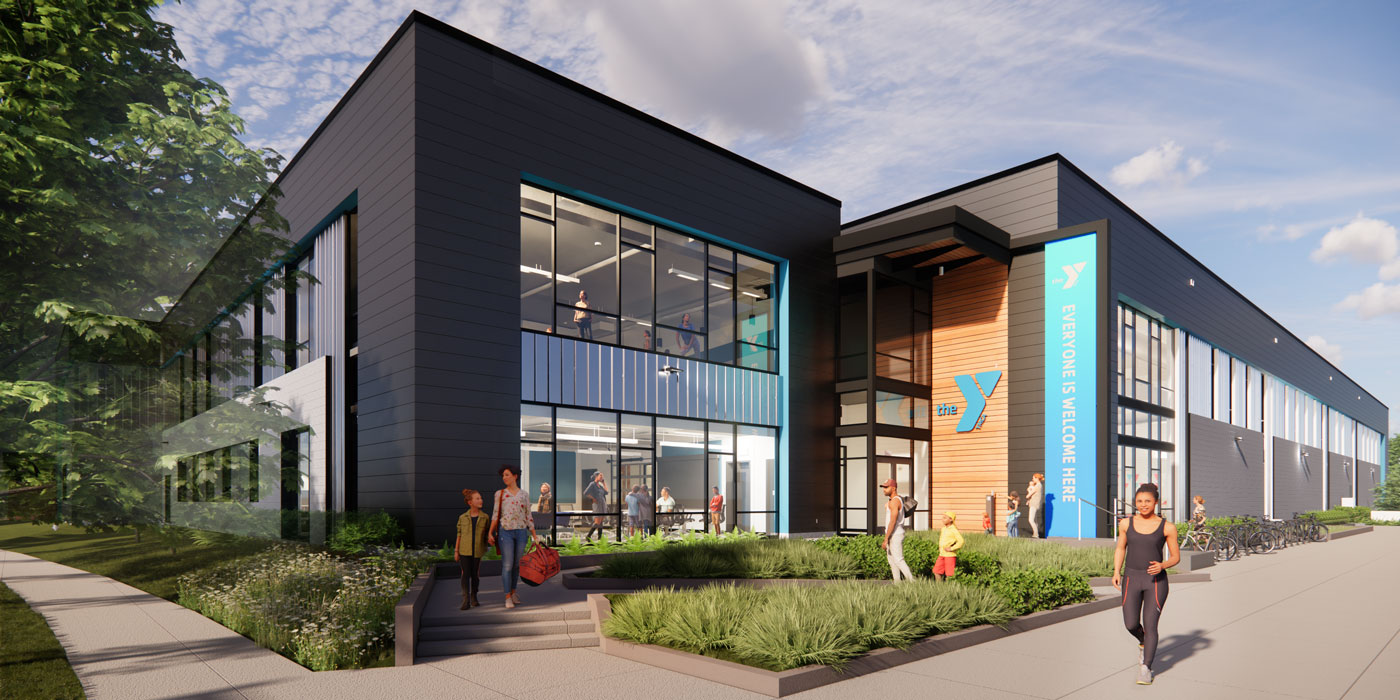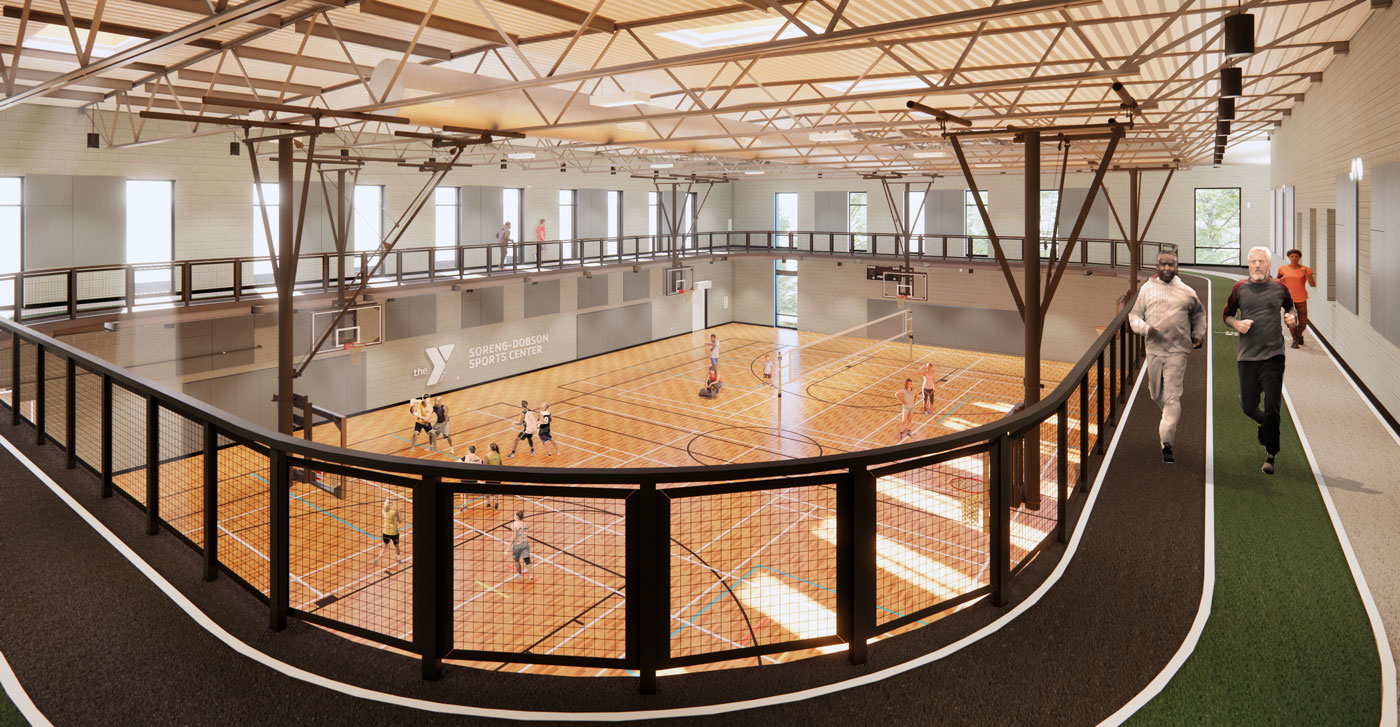Transforming long-cherished spaces is never easy. Yet in South Eugene, the transformation and reimagining of two beloved institutions is coming to fruition. Each fosters not only a devotion to personal health, but also the broader community’s well-being.
On Willamette Street, the Kidsports Fieldhouse now gives kids, volunteer coaches, and staff a dedicated center for local youth athletics where the beloved Civic Stadium used to stand. And on Hilyard, the new YMCA nears both completion of its new, state-of-the-art facility, and a new beginning for the Y’s role in the physical and social health of the Eugene area.

Reimagining the Y
Brian Steffen, CEO of Eugene Family YMCA, knew they couldn’t progress alone. In 2018, Steffen, YMCA staff, and community partners reimagined the Y in a new facility. It couldn’t just be bigger, though. Steffen understood that the new Y needed to build on the organization’s 135-year history. It had to encompass not just fitness, but wellness combined with medical expertise. And they had to bring that to life in a physical space that could be welcoming for all.
“We needed a partner with a different skill set of expert medical insight and guidance,” says Steffen.
Recalling a prior partnership with PeaceHealth in the 1990s, the Y reached out. By 2019, both organizations had developed a clear, shared vision. Then came Covid, when both organizations had to respond to that public health crisis. The partnership with PeaceHealth became final in late 2022.
What has emerged is a first-of-its-kind 10-year partnership that officially kicks off when the Y opens its new facility, currently scheduled for December 2023. Todd Salnas, chief executive for PeaceHealth Oregon, describes the partnership as “invaluable in its ability to reach, guide, inform, and transform lives.”
To support that vision, PeaceHealth contributed $1.25 million. The new Y has dedicated 14,000 square feet of the second floor as the PeaceHealth Wellness Center, which is expected to serve more than 2,000 visitors per day. A standing joint committee, with three members from PeaceHealth and four from the Y, will guide programming.

The current Y has about 38,000 square feet of usable space. With 75,000 square feet of programmable space, the new Y will offer pools, group fitness rooms, an indoor track, a gymnasium, a teaching kitchen, and the PeaceHealth Wellness Center. These spaces enable programs that benefit the community, guided by a real-time understanding of the challenges residents face.
“Based on what they see in ERs and family practices,” explains Steffen, “PeaceHealth comes to those discussions with rich expertise on what’s happening with health challenges in Lane County.”
The organizations can join forces through activities like a joint nutrition class in the Y’s kitchen or a health fair based on community needs. Y health and wellness director Kim Miller envisions the indoor track being used for a new parents’ walking group or a falls prevention program.
“Collaborating with PeaceHealth experts ensures that each and every offering is as robust as possible,” says Miller.

Other partners supporting the new Y include Lane County Medical Society, OCCU Foundation, PacificSource Health Plans, and Trillium Community Health Plan. The new building has a projected cost of $48 million, and $45.3 million has come from partner and community pledges. The new facility is being constructed to the latest seismic standards (and could serve as an emergency shelter and triage center) and includes full ADA accessibility. Private changing and showering pods shift changing areas away from solely gender-specific locker rooms.
“Accessible space ensures the Y can fulfill its mission to be a welcoming place for all,” says Steffen.
He adds that, as a father of five, he gets “regular feedback about what kids would enjoy doing at the YMCA.” With two licensed preschool rooms, two drop-in child care centers, a dedicated room for middle school–age kids, a teen center, a STEAM learning lab, and more, the Y is dedicating 3,800 square feet to expand its ability to serve kids, youth, and families.
Community and partner support also helps the Y serve families and individuals of all backgrounds.
“We will not turn away individuals if they have a financial hardship,” explains Steffen. “No matter where you live or what your background, you have a place at the Y as part of your individual health and education journey.”
For Steffen, the Y and PeaceHealth’s partnership will show how two community leaders can work together to transform health outcomes in Lane County.
“We’re fundamentally altering the programming opportunities we provide families as an organization,” says Steffen. “It’s a reimagination of what the Y can do.”

Getting Kids Moving
When Kidsports executive director Beverly Smith joined the board of Eugene Civic Alliance in 2014, she knew right away that Kidsports would have a broader role. Kidsports and ECA would partner as two nonprofits. The depth and breadth of the Kidsports community would be integral in raising both public support and funding for what, at the time, was planned to be a redevelopment of the beloved yet beleaguered Civic Stadium baseball park. Then, in June 2015, the all-timber ballpark, nearly a century old, burned to the ground.
From communal grief following the loss of the ballpark came a communal vision. Two days after the fire, ECA decided it would stay true to its goals, and they believed the community would support them.
“People have been so generous,” says Smith. “They care about kids.”

By the end of 2015, ECA had raised $4.1 million toward a goal of $30 million. It was enough to purchase the 10-acre site from the 4J school district and begin constructing a fieldhouse, a new synthetic turf field, and supporting amenities. The state of Oregon provided $12 million, and $1 million came from the federal government.
“We have tried to do this so it isn’t a burden on one source but a shared cost for everyone,” says Smith. “To have the first phase be fully funded and debt-free is a tribute to the community and their willingness to help kids.”
Since 1954, Kidsports has made participation in team sports a possibility for local youth. Kidsports enables team athletics and other activities for 15,000 kids a year through complicated scheduling and collaboration with schools and other venues. The organization appreciates their school partners, but Smith and the Kidsports team had no love for the time-consuming challenges in shuffling people and equipment from venue to venue. They also understood how schools could struggle to accommodate Kidsports activities when each school needed its gym or field for their own events.
“We deliver important physical and social learning opportunities for children through sports,” explains Smith. “But we needed a building for a full-size school basketball court that can also be a volleyball court or used for other activities.”

Demand wasn’t slowing down, either. From January to March of 2022-23 alone, 2,900 area kids played on Kidsports basketball teams, requiring 11 different school sites for 154 games per weekend for nine consecutive weeks.
Since opening in 2020, the 40,000-square-foot Kidsports Fieldhouse has helped more than 25,000 children participate in sports and activities. Inside, four courts accommodate a variety of sports, such as volleyball and basketball. The fieldhouse can host summer camps, supplemental practices, and pre-season clinics for football, basketball, and volleyball, as well as other activities including hip-hop dance, self-defense, and a fusion physical education class focused on movement and personal improvement.
“We’re trying to make more things available for kids who are not into a team sport experience,” says Smith.
With fall underway, Smith and the Kidsports team are now focused on soccer, flag football, and volleyball and basketball clinics. Having a central location helps Kidsports better support the 1,400 volunteer coaches that make every game, team, and activity possible. Plus, coaches can now focus more on supporting kids, instead of juggling multiple locations.
“We couldn’t do it without the incredible support from our volunteer coaches,” says Smith. “Coaches know they can come here for meetings, resources, and picking up equipment. It’s much easier.”
She’s found that having a central location also helps community outreach even more, such as with popup summer camps at Title I schools outside the immediate area.
“Some kids can’t get to us, so we come to them,” explains Smith. “We served 1,800 kids last year that way.”

Also completed in 2020, the Market of Choice Turf Field can be striped for any sport requiring a rectangular field, and lights allow for game play night or day, all year long. With Civic Park itself seeing more than 200,000 visitors since opening, a second campaign is now in progress for the final phase: building a 2,500-seat grandstand.
In May 2021, Kidsports increased its involvement and responsibility even more by taking over maintenance and operations for Civic Park, along with the fieldhouse and the field. But they figured they could handle it. When setting goals in 2020, ECA wanted Civic Park to be financially self-sustaining within five years. They achieved it in two.


